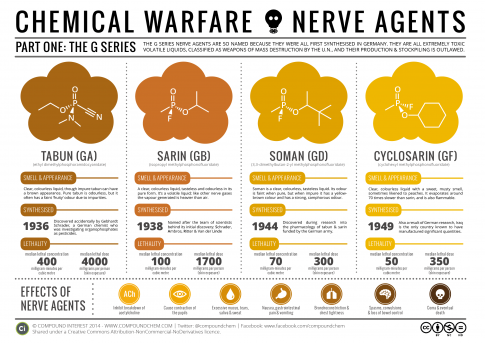What Is a Nerve Agent?

A nerve agent was likely used to poison a Russian ex-spy and his daughter in England...
By Brandon Specktor
A nerve agent was likely used to poison a Russian ex-spy and his daughter in England, new reports suggest.
The former spy, Sergei Skripal, 66, and his daughter, Yulia, 33, were found slumped on a park bench in Salisbury, England, on Sunday (March 4). Both Skripals allegedly looked pale and stiff; vomit was pouring from Sergei's mouth while his daughter sat frothing at the mouth with wide-open eyes, according to U.S. News and World Report.
According to investigators, the condition in which the Skripals were found indicates they were poisoned by a nerve agent — the most toxic and fast-acting chemical warfare agents in the world, Live Science previously reported. But what are nerve agents, and what do they do to humans? [5 Lethal Chemical Warfare Agents]
Simply put, nerve agents stop the central nervous system from communicating with the muscles, organs and glands it needs to keep your body's internal machinery running smoothly. Specifically, the chemicals in nerve agents stop the body from breaking down a neurotransmitter called acetylcholine. The nervous system releases this crucial enzyme to activate muscles; when acetylcholine can't be broken down, those muscles — including the heart and lungs — spasm uncontrollably until they exhaust themselves, becoming effectively paralyzed.
Victims of nerve agents thus lose control of their bodily functions. Unintentional drooling, vomiting and urinating are common symptoms of exposure. Within minutes, the effects can escalate to asphyxiation or cardiac arrest. According to the Centers for Disease Control and Prevention (CDC), the extent of the poisoning increases with the amount and the duration of nerve agent exposure. Nerve agents typically enter the body through the mouth or nose, but can also be absorbed through the skin.
"If you have ever seen a fly sprayed, it drops on its back and lies with its legs in the air, twitching, this is the result of nerve agents taking hold," Dr. Simon Cotton, a senior chemistry lecturer at the University of Birmingham, told the Daily Mail.
Weaponized pesticides
Tellingly, many nerve agents were first developed as pesticides. Sarin, for example — a deadly chemical warfare agent believed to be responsible for the deaths of hundreds of civilians in Syria — was created as a pesticide by German scientists in 1938. In its liquid and gaseous forms, sarin is colorless, odorless and tasteless, making it nearly impossible to detect until poisoning symptoms have already set in. Depending on the degree of exposure, symptoms from sarin poisoning may take only a few seconds to appear. (Sarin and many other nerve agents are banned by the Chemical Weapons Convention, which more than 190 nations, including Syria, participate in.)
It is unlikely that Skripal and his daughter were poisoned with sarin, a source close to the investigation told the BBC. Investigators also believe that the poison in question was not VX (or "Venomous Agent X")— another deadly nerve agent banned by the Chemical Weapons Convention. VX was used to assassinate Kim Jong-nam, the half brother of North Korean leader Kim Jong-un, at an airport last year.
Investigators believe the nerve agent used against the Skripals was "very rare," the BBC reported, and was likely manufactured in a country with a large infrastructure capable of creating and delivering such deadly man-made toxins. It may take days or weeks before toxicologists can provide an answer. In the meantime, the area where the Skripals were found has since been hosed down, which should help dilute any remnants of the chemical agent, an emergency-medicine doctor told Live Science. Nevertheless, the site remains closed to the public. / Live Science.




 del.icio.us
del.icio.us Digg
Digg

Post your comment